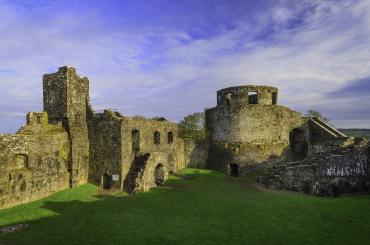Castell Dryslwyn
Visitor Notice
Please keep dogs on short leads only.
Occasionally (as noted on the gate) there will be times when dogs are not allowed to ensure the safety of grazing sheep in the castle grounds. We kindly ask visitors to be understanding and respect this condition.
Fragmentary – yet evocative – remains of a castle laid low by conflict
Founded in the 13th century on an isolated hill in the verdant Tywi Valley, Dryslwyn was once an important seat of the ancient south Wales kingdom of Deheubarth.
Not much is known about its early history, but in 1287 it was the scene of a significant conflict between Welsh and English forces. In response to an uprising by Welsh lord Rhys ap Maredudd, 11,000 English troops were dispatched to lay siege to the castle. The conflict lasted two weeks as siege engines and sappers (soldiers with engineering skills, including tunnelling) chipped away at the fortress’s defences. The attackers eventually brought down a large section of the walls and the castle fell into the hands of the English crown.
Opening times & prices
Opening times
| 1st April - 31st March | 10am–4pm |
|---|---|
|
Last admission 30 minutes before closing Closed 24, 25, 26 December and 1 January |
|
Visitor information
Car park
Public car park opposite main entrance with 15 spaces, no dedicated disabled parking bay.
Dogs welcome
Please keep dogs on short leads only.
Occasionally (as noted on the gate) there will be times when dogs are not allowed to ensure the safety of grazing sheep in the castle grounds. We kindly ask visitors to be understanding and respect this condition.
Walking difficulty
Terrain: Level 4 – Strenuous
Drone policy
Please read our policy information about flying drones at Cadw monuments: read the guidance
No smoking
Smoking is not permitted.
Health & Safety
Dryslwyn Castle is located high upon a hill in the Tywi Valley, access is through a steep climb from the lower car park. Visitors are required to cross the main road to access the entrance gate. Please take care of fast-moving vehicles here.
The path consists of a series of steps, gravel and natural paths. This may take up to 20 minutes, but the view is worth it!
There maybe small livestock around the castle during your visit, please do not approach them and keep all dogs on leads.
Naturally the grounds here are uneven and may be wet / muddy during poor weather conditions. Please use handrails where provided on the steps, these are historic original stone steps and may be uneven.
Guardrails have been installed to prevent access to any areas of the site that we have deemed as dangerous or to prevent falls in specific areas.
Please do not climb over or through any fixed installation or on the castle masonry; there are areas with hidden drops.
As with all ancient monuments there is always a risk of stones being dislodged in bad weather, however, we manage this through extensive monitoring.
Climbing may result in serious injury.
There are several wild plants and flowers, although these are great pollinators, they may be poisonous to visitors and animals, we strongly advise you not to touch or allow dogs to eat any vegetation.
Please watch our health & safety film before visiting Cadw sites.
Iechyd a Diogelwch / Health and Safety
Please report any anti-social behaviour such as climbing, setting fires, graffiti etc. to CadwAccidentsReports@gov.wales
Some or all of the following warning signs may be found situated around the site. Please pay attention where appropriate.
Falls from height
Steep and uneven steps
Slippery or uneven surfaces
Falling masonry
Directions
Google MapGrid Ref: SN553202. Lat/Lon: 51.8623, -4.1015
what3words: ///thin.latitudes.toolbar
For further information, please contact: Traveline Cymru on 0800 464 0000 or National Rail Enquiries on 03457 48 49 50.
Unlimited access to Wales' past
Join Cadw for as little as £2.00 a month and gain unlimited access to over 100 historical sites.
Enjoy the many benefits of Cadw membership
- 10% off Cadw gift shops
- 50% off entry to English Heritage and Historic Scotland sites
- FREE entry to English Heritage and Historic Scotland on renewal
- FREE entry to Manx National Heritage properties
- FREE membership pack including car sticker and full colour map
